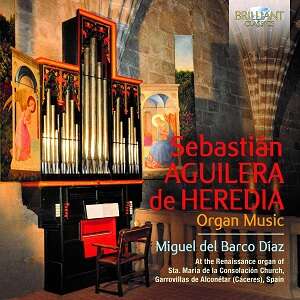
Sebastián Aguilera de Heredia (1561-1627)
Organ Music
Miguel del Barco Díaz, organ
rec. 2019, Garrovilas de Alconétar (Cáceres), Spain
BRILLIANT CLASSICS 96180 [76]
Brilliant Classics has made a name for itself with its recordings of keyboard music from across Europe. The largest part of the label’s catalogue in this category comprises music of the renaissance and baroque eras. Part of that are recordings of the complete keyboard works of the best-known composers of these periods, such as the Bach family, François Couperin and Domenico Scarlatti. However, one can also find many unfamiliar names in the list of composers, and Sebastián Aguilera de Heredia has to be counted among them. Only those who have a particular interest in Spanish music may know him and (parts of) his oeuvre.
Aguilera de Heredia was born in Zaragoza, and there he spent most of his life. He probably studied with Melchior Robledo and Juan Oriz, respectively maestro de capilla and organist at the Catedral del Salvador. When the latter died in 1603, Aguilera de Heredia succeeded him. He held this post until his death. During his service, he regularly required reparations of the organ, which were performed according to his wishes. Among them was the installation of half stops, which were introduced in Spain by Flemish organ builders. And that brings us to one of the reasons why Spanish organ music is seldom performed outside Spain.
Few instruments elsewhere have both the registers that are characteristic of Spanish organs and the split of the manuals in two halves with their own disposition. The latter is needed for a typical Spanish genre: pieces whose titles include terms like de bajo (in the bass) and de tiple (in the alto) or, with a reference to the hand which had to play the respective parts, de mano izquierda (in the left hand) or de mano derecha (in the right hand). In Aguilera de Heredia’s oeuvre one finds only one such an indication, in Registo baixo de 1° tom. However, a number of them are written in this way. It is notable that the ‘solo part’ is always in the left hand. Such pieces are in the tiento genre (sometimes also called obra), comparable with the fantasia or the ricercare in Italian keyboard literature.
Two pieces have the indication de falsas, which refers to the frequent use of dissonances. It is in particular these pieces which show the development towards a ‘baroque’ idiom. A remarkable piece is Obra de 8° tono alto ‘Ensalada’. An ensalada, literally a ‘salad’, was a particular genre in Spanish vocal music of the Renaissance, a kind of quodlibet of different styles and texts, often a mixture of sacred and secular elements, with a satirical tenor. In this piece Aguilera de Heredia translates this genre to the keyboard. No wonder that Miguel del Barco Díaz is changing the registration frequently, especially as the organ he plays, has only one manual and no pedal.
This piece is all the more remarkable as Aguilera de Heredia exclusively composed for the liturgy. One wonders when such a piece may have been played. That is easier in the case of the four pieces that refer to liturgical chants: two are based on the Marian antiphon Salve Regina and two on the hymn Pange lingua. Unfortunately, Belco Díaz does not discuss single pieces in his liner-notes, and therefore I don’t know what the word “saeculorum” refers to (Discurso sobre los Saeculorum). Obviously this word is part of the doxology, but from which chant?
Aguilera de Heredia has left eighteen organ pieces; all of them are recorded here. The work-list in New Grove also mentions six anonymous tientos, among them a tiento de batalla, that are attributed to him, but these are not included here. I don’t know how many times these pieces have been recorded complete; I found at least one on our old site (review), but then as part of a larger collection of organ music. Organ aficionados should not miss this disc anyway. The organ dates from before 1578; the half stops were probably added in 1677. It is a very fine instrument, that seems perfectly suited to do justice to Aguilera de Heredia’s oeuvre. Add to that the excellent playing by Miguel del Barco Díaz and his sensitive use of the colours of this organ, and one will understand that this disc is another fine contribution to the Brilliant Classics keyboard music catalogue.
Johan van Veen
www.musica-dei-donum.org
twitter.com/johanvanveen
Help us financially by purchasing from



Contents
Salve de lleno de 1° tono (I)
Salve de 1° tono por De-la-sol-re (II)
Pange lingua por Ce-sol-fa-ut (III)
Pange lingua (IV)
Vajo de 1° tono (V)
Obra de 1° tono (VI)
Tiento de 4° tono de falsas (VII)
Tiento de 4° tono (VIII)
Falsas de 6° tono (IX)
Obra de 8° tono alto ‘Ensalada’ (X)
Registo baixo de 1° tono (XI)
Vajo de 1° tono (XII)
Obra de 1° tono (XIII)
Tiento de 4° tono de falsas (XIV)
Dos vajos de 8° tono (XV)
Tiento de 8° tono por Do-la-sol-re (XVI)
Obra de 8° tono por Ge-sol-re-ut (XVII)
Discurso sobre los Saeculorum (XVIII)


















